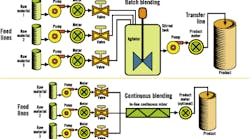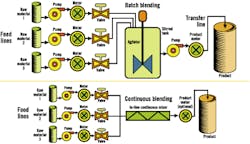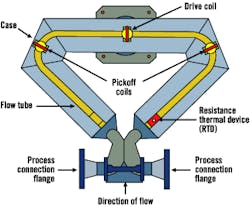Coriolis flowmeters can help improve the accuracy of batch blending, dilution and continuous blending operations. These meters sense the mass flow rate at a high degree of accuracy and sensitivity, transforming the rate into an analog or frequency output.
Coriolis flowmeters offer chemical and other industrial facilities on-line measurement of mass flow, density and volumetric flow. They have an accuracy of +/-0.1 percent and are capable of multivariable measurement ," volume, mass, density and temperature. Because they have no moving parts, maintenance requirements are reduced. They are available in a wide variety of sizes and flow capacities.
This article takes a look at some of the challenges associated with batch blending, dilution and continuous blending operations, and examines how coriolis flowmeters can improve mixing accuracy and cut downtime.
Batch blending
Proper blending is important to many products because they need to have a specific taste, smell, texture, viscosity and/or appearance. For example, a slight error in ketchup blending can translate into dispensing problems at the dinner table.
Blending operations in the chemical industry produce different grades of finished products. Because many chemical facilities use the same equipment for multiple recipes, the equipment, instrumentation and control valves must be able to operate with precision across a wide range.
Traditional batch blending, however, can adversely affect a chemical plant's overall efficiencies in at least four ways.
First, the addition of one ingredient after another, called sequential addition, can amount to hours from the first addition to completion and transfer. Much of this time is required to expose the fluids to their reaction partners or to homogenize a mixture.
Second, batch blending requires a great deal of valuable floor space for the large equipment.
Third, batch blending requires a larger finished-product storage area. Space must always be available for the next batch transfer.
Finally, batch blending involves much more equipment than continuous blending. See Fig. 1.
Figure 1. Comparison of Conventional Batch and Continuous Blending
Continuous blending requires smaller equipment, less floor space and a smaller product storage area than batch blending.
Small additions cannot be accomplished accurately if a single large scale is used. If used, they can be expensive to maintain and keep in calibration. Agitators also affect weigh cells. Noise resulting from liquid turbulence must be filtered out. This equipment usage requires more maintenance than continuously operated smaller equipment.
Volumetric meters have a lower accuracy than coriolis meters, and some have longer ramp-up and decay periods, leading to inaccuracies. Additional power is consumed for pumps and agitators, and more pressure and level instruments are needed.
Dilutions
Dilutions are a major blending application. Household, agricultural and other mixtures and solutions often have one or more concentrated or powerful components that are blended into an inert carrier ," often high-purity water.
The reasons for dilution are many. Sodium hydroxide and other caustics can be very viscous or even freeze in mild climates. Glacial acetic acid will freeze below 62 Degrees F. Hydrogen peroxide and other peroxides can react violently when the concentrated form is contaminated. Some reagents can be distributed in more affordable piping systems when dilute. Accurate blending during dilution is important, therefore, to ensure performance and reduce cost.
Somewhere, at the use points, composition is important. The best place to dilute is as close to the unloading point as possible. Using two coriolis meters, purchased fluid, water and blended stream mass flow rates can be determined to less than 0.15 percent of rate inaccuracy, and density can be determined within 0.0005 gram per cubic centimeter (cc).
Plants potentially could handle their bills of lading and formulation needs at the same time. Plants even might be able to skip those repairs to the rail scales.
Continuous blending
Reactions have many metering needs. The traditional stirred batch reactor has not disappeared, but it has changed. In large part, competition has eliminated the separation stage after many reactors. It is much preferred to blend reactants precisely rather than to remove the overcharged component after reaction. Equipment and energy costs are eliminated, and the cycle often is improved.
The greater trend in reaction is continuous processing. With continuous blending, however, plants have only one chance to do it right. Rework is usually not an option, and co-incident precise ratios are a must. For loop, stirred and plug flow continuous reactions, even pressure/temperature-compensated volumetric metering might not yield sufficient accuracy.
Continuous blending ," measuring and mixing raw materials within the pipe as the material flows to produce exact proportions and meet specific recipe requirements ," delivers the same accuracy as ," or better accuracy than ," batch blending.
Although continuous blending can alleviate many of the shortcomings of batch blending, some facilities resist the change because of their "corporate culture." Manufacturers like to stay within their comfort zone and might be wary of an unfamiliar procedure. Moreover, many plants have invested heavily in batch blending equipment and are hesitant to replace it.
Return-on-investment (ROI) analysis could show the idled tankage could be used for surge or storage capacity. The changeover often is made after a continuous expansion or de-bottlenecking has occurred.
One major benefit of continuous blending with automatic control is enhanced operator safety. The elimination of mix tanks reduces operator risk from material exposure, and eliminates both inert blanketing of related vessels and entry permits. In addition, continuous blending allows a smaller amount of noxious materials at any one location.
Coriolis and continuous blending
One processor of home products successfully installed several lines of continuous blending modules. One stringent requirement of this processor is that the finished products must be perfect, with no variations in product quality. To help accomplish this, the processor decided to use only coriolis meters.
Typically, continuous blending units such as the one used by the home products processors are designed and shipped as pre-assembled and tested modules that measure about 12-feet (ft.) wide, 50-ft. long and 8-ft. high. Each module contains a coriolis meter and a metering valve for each ingredient, as well as many transmitters for pressure and temperature, static mixing, a control panel for the programmable logic controller (PLC) and other instrumentation. Spool pieces can be removed to make process changes or to add process analytical equipment.
Many continuous processes are in some respects batch processes in the sense that the modules could run for years without change. The home products processor actually has more process flexibility than that. Processing durations or operating rates can be adjusted to suit a just-in-time market; additional inputs can be used for new ingredients or clean-in-place (CIP) fluids. The individual input line metering system can be used for detergent conservation and high-purity water.
Coriolis meters offer more than mass flow rate signals. They include volumetric flow, fluid temperature and density, and calculated density-type variables such as Brix, American Petroleum Institute (API) and others. In addition, a 4-20 mA direct current signal from a pressure transmitter can be fed into the flow transmitter and re-transmitted digitally, saving wiring. Fig. 2 shows a cutaway view of a coriolis flowmeter.
Figure 2. Cutaway of a Coriolis Flowmeter
Coriolis meters offer volumetric flow, fluid temperature and density, and calculated density-type variables. Drawing courtesy of Micro Motion
Conclusion
Continuous blending offers a time- and space-saving alternative to batch blending. When coriolis meters are used in an automatic-control continuous blending application, whether the application is an upgrade of an existing process or installation of a new process, chemical plants can:
Improve product quality.
Enhance on-stream time.
Optimize floor space.
Reduce staffing costs.
Improve safety.
Improve process information from control system.
Boost product delivery reliably.
Minimize waste disposal. CP
Donovan is an applications engineer for FABCON, a division of PC & E in St. Louis. PC & E is part of Emerson Process Management. He can be reached at [email protected].
Some coriolis meters might have "unadvertised" capability ," in the home product processor's case, a relative-viscosity calculated variable. Although not in standard units of poise, saybolt seconds universal (SSU) or stokes, the variable is relatively accurate and repeatable. It is an important quality variable. Any of these signals, as well as mass flow and density, can be transmitted. Hart, Modbus, Profibus PA and Foundation fieldbus are all available, depending on model selection.The use of coriolis meters can improve blending operations, however, providing a highly accurate automated approach. In batch blending operations, the only measurement technique that can approach the accuracy of coriolis meters is weigh cells. However, for these cells to achieve a reasonable accuracy, a weighed tank must be supplied for each ingredient, and concentrations of feed solutions must be accounted for, typically by density measurement.




